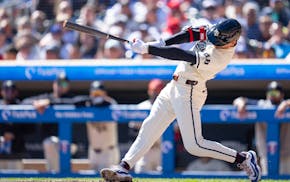Jimmy Butler's 37-point performance Monday against the Portland Trail Blazers in a game in which he was questionable to play because of back issues was an old-school demonstration of determination and grit.
When the story of the Wolves season is ultimately told, I have a feeling we will remember how Butler and Jamal Crawford absolutely willed the Wolves to a one-point win over Portland while changing the tenor of the entire five-game homestand.
Butler's final offensive play, though, when he drove baseline, got fouled near the rim and made two free throws for the winning margin, was a nice mix of old school and new school.
Traditional basketball wisdom says a drive to the basket in an end-of-game situation is better than a jump shot because more good things can happen. That notion marries well with advanced stats, which have taught us the most efficient shots in basketball, by far, are either three-pointers or shots at the rim. The least efficient shots, by contrast, are long two-pointers.
The Timberwolves' offense this season has been somewhat of a paradox. They rank fifth in offensive rating per Basketball Reference (an estimate of points scored per 100 possessions) at 111.6 But they also take — some would say settle for — a lot of inefficient two-point shots.
Of the Wolves' shot attempts this season, 73.2 percent have been from two-point range, the third-highest percentage in the league. The Wolves are excellent when they get to the rim, making 70.2 percent on those shots (third best in the NBA). But by percentage of overall attempts, Minnesota lags behind at No. 22 in terms of shots taken at the rim (26.1 percent).
So more than half the Wolves' shots (53 percent) are neither at the rim nor from three-point range. That's a lot of less-than-ideal two-point shots.
The Wolves have a good offense despite their drawbacks. They finish well in close, and they get to the free throw line at a high rate. But they could be even better if they didn't settle for as many midrange or long two-pointers.
In this regard, the finger can be pointed at a lot of players. But the biggest culprit might be Butler's wing mate Andrew Wiggins.
Wiggins entered play Monday having attempted just 22.8 percent of his overall shots at the rim. Last year, his rate was 29.1 percent, and it was up over 30 percent each of his first two seasons in the league. Most observers would agree Wiggins is too dangerous attacking the rim to settle for jumpers.
Monday's game was a good example. Wiggins was 4-for-14 from the field — 3-for-4 at the rim, 1-for-10 on all other shots.
By contrast, eight of Butler's 11 makes were from inside the paint, including five layups or dunks. For the season, 25.9 percent of Butler's shots have come at the rim.
He also banks in a lot of shots in the paint that are virtually layups but don't count as true shots at the rim for statistical purposes.
Butler was rewarded in the closing seconds Monday for his aggressiveness. He didn't get a basket at the rim, but he got the next best thing with a foul and two free throws.
Butler needs to keep that up — while getting Wiggins and other teammates to follow his lead — if the Wolves are going to turn a good offense into a great one.

Live: Minnesota United at Charlotte FC. Follow on Gameview.
Jameson Taillon comes off the injured list and helps the Cubs beat the Marlins 8-3
T-wolves take NBA's best defense into series vs. Suns, but can it stop Durant-Booker-Beal trio?

